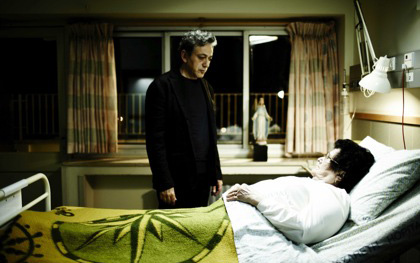Close up
The song remains the same

The Time That Remains sees director Elia Suleiman take on the monotony and stasis of life under occupation with his own brand of deadpan cinematic minimalism. Adania Shibli is moved
» Read Ali Jafaar’s interview with Elia Suleiman
Elia Suleiman’s The Time That Remains deals not only with what remains of a time, but also with what remains of a place – his homeland, Palestine. The film begins with a taxi leaving Lydda airport with a mysterious passenger, the only sign of whom is a suitcase the driver is seen putting in the boot. During the journey the driver – an Israeli – is in full view in the front seat, while all we see of the passenger is a silhouette in the back. Suddenly a storm breaks out and it becomes impossible for the driver to see the road ahead. The radio cuts out – and the journey ends there. The film goes on to present four more situations, each of which ends with a similar disruption of time and space, except with more ominous consequences.
The first of these occurs in 1948, when the Haganah – which will become the core of the Israeli army – occupies Nazareth. Fuad Suleiman’s girlfriend is forced to flee Palestine, while Fuad stays behind to fight, before he is arrested and tortured. When we meet Fuad again in Nazareth at the end of the 1960s, he is married to a different woman – and has a son called Elia, who is almost ten. The film follows the day-to-day life of the family and their neighbours, who live under a regime of extreme monotony: one strives to think logically in a state of complete intoxication, while another tries to commit suicide but is saved by Fuad and others, only to try again and again. But when anyone attempts to leave Nazareth and escape this monotony, they encounter obstacles that are themselves monotonous. When Fuad goes fishing with a friend, they have their papers checked by a military patrol, who keep turning up again and again.
While Fuad’s generation is restricted in terms of their movements, his son Elia’s generation is subjected to indoctrination, forced to chant Zionist songs at school. But though the children learn them by heart, when it comes to clapping at this or that point they hesitate, revealing the failure of the rhythm of these stirring songs to ignite any spontaneous feeling in them. The same failure is seen again when the headmaster’s reprimand of Elia for calling America colonialist achieves nothing – except to make Elia call America imperialist the next time.
Many of the film’s scenes not only portray similar situations, but do so using similar camera style, in terms of position, distance and frame. Thus all that really changes is the time the characters traverse – they grow older while remaining confined to the same places.
The next disruption in time and place occurs when Elia is a youth, busy transporting his now elderly father to hospital for treatment. One day he is told he must leave the country as the Israeli authorities are planning to arrest him, even though his involvement in political activity consists only of observing a clash between some Israeli policemen and Palestinian youths. But it seems involvement in political activity begins the moment one watches.
Though the film, like Suleiman’s other work, is undoubtedly political, its cinematic form and content are marked by a studied yet subtle simplicity. He uses minimal action to escape the prison whose architecture The Time That Remains depicts in detail – an escape that requires enormous strength, greater than that of the occupier or of a pole-vaulter capable of surmounting the eight-metre wall constructed in Palestine.
Two sequences sum up his project. In one, following Fuad’s death, we see Elia’s mother sitting alone one evening on the balcony. The sky fills with fireworks, celebrating the 60th anniversary of the establishment of the state of Israel. But she turns her eyes away, preventing the display from achieving its goal, which is to attract attention and dazzle. It is a simple act of resistance, of simply not looking – and thus blocking out the occupiers and their capacity to overawe and terrorise.
If resistance takes the form of small actions, so too does pleasure. In another scene, the mother is sitting alone on the balcony again, in silence, when Elia puts on a song. She then gently swings her leg under the table in time with the music. Speech may be as futile in The Time That Remains as when Chaplin first speaks in Modern Times (1936), but music plays a vital role. Suleiman’s strength is that of the cinematic imagination.
‘The Time That Remains’ is released on 28 May, and reviewed by Philip Kemp in the June 2010 issue of Sight & Sound.
» Read Ali Jafaar’s interview with Elia Suleiman
See also
Palestine: invisible lands: Adania Shibli on London’s 2010 Palestine Film Festival (online, April 2010)
Not forgotten: Adania Shibli on Sarah Wood’s For Cultural Purposes Only and the lost Palestinian Film Archive (online, November 2009)
Bomb culture: B. Ruby Rich on Hany Abu-Assad’s Paradise Now (April 2006)
Paradise Now reviewed by Ali Jafaar (May 2006)
